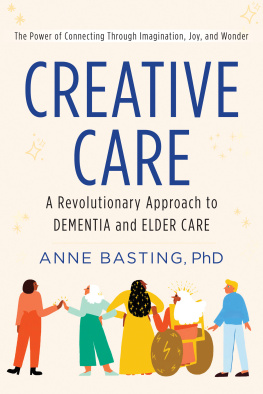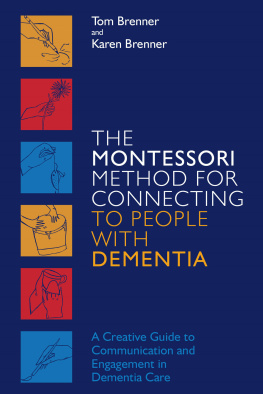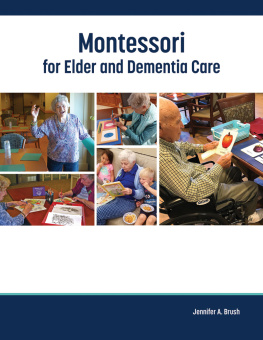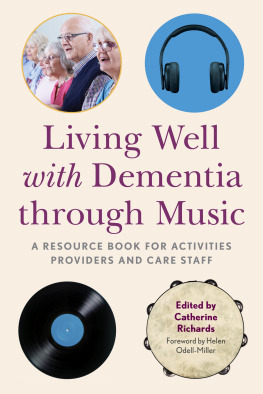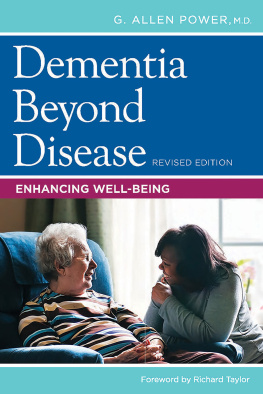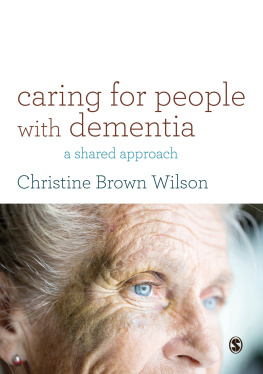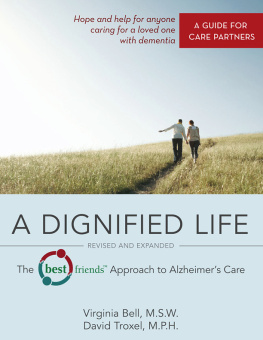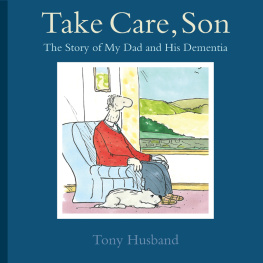I t was opening day. Spirits were incredibly high. I had walked into Morgantown Care and Rehabilitation in Morgantown, Kentucky, that Saturday morning to a chorus of exuberant greetings, not what youd usually expect at a nursing home. Now it was just about 2 p.m.showtime. After two weeks of rehearsal and a year of planning, the elders, local actors, volunteers, and staff were about to perform their version of Peter Panone in which Wendy is in hospice care in her final phase of growing up. And the audience, rather than clapping to prove their belief in fairies, would meet the extended hand of an elder to prove that they believedin one another. There would be song and dance, there would be a giant crocodile, pirates, and of course flying. These residents, several of whom had not been out of their rooms for months, were about to welcome an audience to see them and their nursing home in a completely new light. They were inviting the audience to see beauty and meaning in a place where most people see only overwhelming loss.
Ruth had been at every rehearsal. If I had to guess, I would say Ruth was in her late eighties, with a bob of gray hair framing her face. Riding a wheelchair, she was one of the dozen elders dancing in the finale to Frank Sinatra singing Fly Me to the Moon. As Shirley, a resident who had been the activity director in this very nursing home for forty years, offered a blessing on the performance, and the stage manager called out, Places! Ruths care partner wheeled her out onto the homes front patio for the pre-show. The wind carried a chill, but every elder in the dance chorus insisted on going outside to greet the audience and listen to the live music. I looked around at the faces. Every one of them was wide-eyed and wonder-filled. Except Ruth. She was crying. Her eyes were bright, but tears rolled down her cheeks. Her mouth was twisted into a half-smile, half-grimace. I went to her straight away, kneeling down in front of her and taking her hands. Ruth! I whispered. Are you okay?
She nodded eagerly.
Are they happy tears? I asked.
Oh, yes, she said with a laugh. Happy, happy tears.
Happy tearstheres no better phrase to capture a feeling of joy in a time of tremendous challenge, such as when we create and experience poignant beauty in, say, a time of dementia, or a time of profound physical changes, or a time of powerfully missing people who have gone on before you or who are too far away or too busy to visit. In my twenty-five years of bringing the arts to people in late life, almost no one believes me when I first suggest it is possible to feel joy in these moments. Or that joy and meaning can coexist in some of the hardest times of our lives, if we are lucky enough to live that long. The power of being invited into creating meaning, of working together to create art that has a lasting legacy, is an elusive thing to describe. But when people feel it, they understand it deeply. Im fairly confident that in the beginning of their training, the staff at the nursing home in Morgantown didnt believe in that power. Nor did the elders, or their families. But after the show, they sure believedin themselves, in one another, and in the power of the shared creative experience.
I didnt always believe either. I didnt even know it was a thing that could be believed in. My journey toward the performance of Wendys Neverland in a nursing home in Morgantown was a long, slow discovery for me, a gradual accumulation of experiences rather than a lightning strike. I continue to learn every day, especially now, as the landscape of time shifts under my own feet, bringing changes to my own family. It is my hope that the stories Ive gathered here, stories of how I learned to apply the insights from theater and creativity studies to the world of elder care and memory loss, stories of bringing joy and connection to those who thought these possibilities were gone, stories from my many encounters with elders and care partners, offer readers a similar journey toward discoverya journey toward believing that beauty, growth, learning, and joy are all possible in moments that most people assume to be overwhelmed only by loss and sorrow. My hope is that by reading this book you can follow in my footsteps and transform your relationships with people experiencing dementia and other challenges that can accompany aging.
Theres an urgency to my hope of course. At this point, nearly everyone knows someone who is experiencing symptoms of physical and cognitive changes that can come with age. Some are mild, not much more than a nuisance and a topic for bonding laughter at dinner parties. Some progress cruelly in ways that bring dramatic changes to every aspect of our lives.
This person might be your neighbor. He might pause when he sees you, squinting to try to recall your name, then turning and hurrying back to close the door before you have a chance to offer your usual warm greeting. This person might be your wife of many, many yearsan unfamiliar knot of worry growing behind her brows, a slight, haunting distance when your eyes meet. This person might be your father, in your mind always regal and confident, now hesitant and uncharacteristically cautious.
With the numbers as they are now, with successes in public health increasing life expectancy across the world, we are in a new era of adjusting to the realities of living into late life and the range of changes that might bringwhether physical or emotional. How will we navigate them? As sons and daughters? As spouses? As neighbors? How will we navigate these changes as communities? As cultures? As a species?
This has, of course, also been a personal journey. Mine has been long and slow, a million steps toward understanding the ideas at the root of creative care. Just as I set out as a young scholar and artist, bucking stigma and market forces to focus my attention on aging and dementia, whole fields began to form around me. I had the dumb luck of falling into an idea whose time had come. In the beginning, I didnt know what a boomer was. But they were already starting to rattle the bars of the cage that kept stereotypes of aging in place. The academic field of age studies was already starting to form in the humanities as I started my dissertation. Disability studies came into its own and now has departments and centers, majors and minors across the world. Creative aging formed as a field, with nonprofit arts companies popping up from San Francisco to London. It was built by pioneers like Pam Schweitzer, Gene Cohen, Susan Perlstein, Stuart Kandell, and Ann McDonough, to name just a few, whom I have had the great fortune to know and call colleagues and friends.
I first stepped into this work in my twenties. Inevitably, this meant that when I told people that I worked with people with dementia using the arts, brows would furrow and eyes would narrow. The thought bubble above their headswith the words sometimes also spoken aloud, sometimes notasked, Why would you want to do that? and then Do you have someone in your family with dementia? The answer was too complicated for passing conversations. My response was usually, No, not really. That was never satisfying to anyone. Brows furrowed more deeply. I was an aberration. Aging and dementia are depressing, those brows said. No one really wants to think about it, let alone a young woman in her twenties with light and hope leaking from every pore.
In my thirties and on through my forties, I continued to think and write about aging, and how the arts could both reshape how people think about aging and foster growth and meaning in late life. I followed in the footsteps of community-engaged artists working in fields of criminal justice, housing and homelessness, environmental justice, and education. Many of the stories in this book are from that period of creative experimentation, when I began to step away from traditional scholarship of my earlier books and more toward art-making with elders who became collaborators and friends. They generously opened themselves to risk and growth in the creative process and shared with me their stories of pushing through challenges like failing memories, physical frailty, and crises of confidence to make something beautiful, together.

